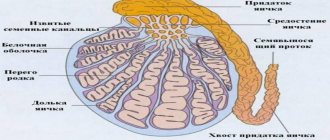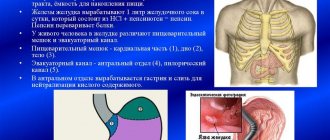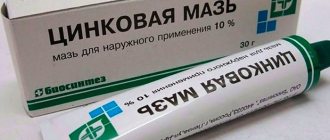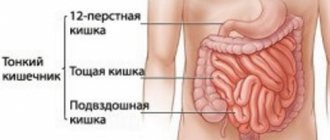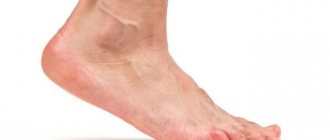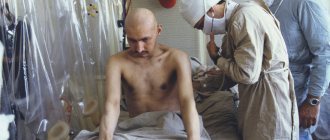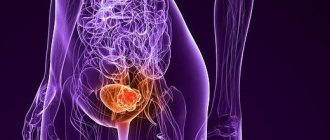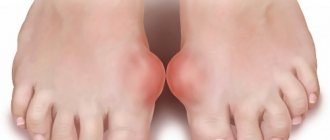21.12.2014
78592
Your long-awaited baby smiles and gurgles, looking into the very depths of your soul with his devoted and loving gaze. You catch his every new movement, smile, sound... And suddenly you notice that something has gone wrong...
The baby always turns his head only in one direction, even if it would be more convenient for him to do exactly the opposite, he still always keeps his head in one direction.
Be vigilant, your baby may have torticollis!
- The following phenomena can cause the formation and development of torticollis in a baby:
- Which children are at risk
- What does torticollis look like in children?
- How to cure torticollis in a child
Conservative method of treating torticollis in a child
- How can mom help?
- Surgical treatment of torticollis in a child
The essence of pathology
Neck deformity can develop as a result of pathology of any of its anatomical layers - osteoarticular, muscular-fascial, skin. It is visible immediately after birth or increases gradually. The chin is brought to the chest, and the face is turned to the healthy side. Eventually asymmetry of the head develops.
Torticollis ranks third in the pathology of skeletal development in newborns.
Torticollis in infants: signs
Torticollis in infants is often a congenital pathology. In this case, it appears immediately after birth or within 10-14 days after that. Congenital torticollis is usually a muscle disorder. Treatment is prescribed with medication after a mandatory consultation with a neurologist. Signs of torticollis in infants depend on the form of the disease, and there are quite a few clinical forms that arise during the baby’s life. The most common of them are the following:
- Installation. With this disorder, tissue damage does not occur; the pathology is primarily due to the fact that the child is constantly in the same position, for example, lying on only one side. Often, installation torticollis in infants develops as a result of strabismus.
- Neurogenic. This pathology appears when the nerve endings are infected. Other manifestations of such a lesion may include spasms and sharp muscle contractions, similar to cramps.
- Traumatic. This type of torticollis occurs with dislocations, subluxations and fractures of the upper vertebra (atlas).
- Desmogenic. The development of this form of pathology is associated with hypothermia in infants, respiratory diseases, inflammation of the lymph nodes and other similar diseases.
There are other forms of torticollis, but they tend to occur in older children.
Causes
The cause of torticollis in newborns was previously called incorrect position of the fetus or entanglement in the umbilical cord. It has now been reliably established that without organic changes, torticollis will not develop. But birth trauma can lead to neck curvature.
- Deformation of the cervical spine is caused by wedge-shaped vertebrae, accessory vertebrae, their fusion, the presence of cervical ribs, infectious or tumor pathology of bone tissue, fractures, dislocations or subluxations of the joint between the skull and the first vertebra.
- Changes in the muscular system are caused by pathology of the sternocleidomastoid muscle, less often the trapezius muscle or its innervation: developmental anomalies, scarring, inflammation, deposition of calcium salts or ossification, cerebral palsy tumors, poliomyelitis, encephalitis, space-occupying formations in the brain or along the nerves innervating the muscle, trauma these nerves.
- Pathology of soft tissues: pterygoid neck, severe scarring, interfascial phlegmon, lymphadenitis.
A separate group includes compensatory torticollis, caused by a forced position of the head due to strabismus and hearing impairment on one side. It can also be provoked by parents themselves by placing the child on one side or placing toys (or a light source) on one side.
Types of diseases and their causes
Depending on the period of occurrence of torticollis, it happens:
- congenital. Formed during the intrauterine development of the child or during childbirth;
- acquired. Formed after the birth of a child.
Based on the reasons for its appearance, there are the following types of torticollis:
- bone The congenital form is formed due to the atypical structure of the cervical spine: abnormal shape of the vertebrae, the appearance of additional cervical ribs. The acquired form occurs as a result of dislocation or fracture of the vertebrae of the neck, tuberculosis, osteomyelitis (infectious process in the bone and bone marrow), spinal tumors;
Additional cervical ribs can provoke the development of congenital torticollis - muscular. Formed due to impaired development of neck muscles. The congenital form occurs as a result of birth injuries, incorrect position of the fetus in the womb. The cause of the acquired form is diseases: acute or chronic myositis (muscle inflammation), sarcoma (malignant tumor);
- dermatogenic. Rarely diagnosed. The congenital form is formed due to a genetic malfunction. As a result, wide skin folds form in the neck area. Acquired torticollis appears due to tissue scarring after surgery, burns or damage to the skin;
- neurogenic. The main reason for the development of this type of disease is damage to the nerves that control the neck muscles. There are two options for the development of pathology: first, the nerve that controls the neck muscle is damaged; second - damage occurs to the nerve node located in the cerebral cortex. Congenital neurogenic torticollis occurs due to hypoxia (lack of oxygen) of the fetus and intrauterine infections. The causes of the acquired form are poliomyelitis (spinal paralysis), encephalitis (inflammation of the brain), cerebral palsy (cerebral palsy);
- compensatory. Appears after the birth of a child due to deterioration of vision or hearing loss. The child compensates for the visual or auditory defect by intense turns of the head. As a result, the tone of the neck muscles increases;
- reflex (pain). It can only be purchased. Occurs due to inflammatory processes occurring in the parotid glands, collarbone or mastoid process. The symptoms of torticollis disappear after successful treatment of the underlying disease;
- installation It only has an acquired form. Develops in the first year of a child’s life due to improper organization of sleep and games: the baby sleeps all the time on the same side, toys are always located on the same side of the baby;
- false. It occurs due to increased tone of the neck muscles. It is not true torticollis. It is treated quickly and easily.
Depending on the location of the inflammatory process, torticollis occurs:
- right-sided;
- left-handed;
- two-sided.
With right-sided torticollis, the baby tilts his head to the right shoulder, with left-sided torticollis - to the left. The bilateral form of torticollis occurs rarely and is difficult to treat. With this type of pathology, the child can hold his head in two positions:
- press to the chest;
- tilt back.
Symptoms
Osteoarticular
- Bone deformations are accompanied by shortening of the neck up to its apparent absence. The scalp ends at the top of the shoulder blades. The head is brought to the chest and tilted to the side, and the range of movements is very limited. There is asymmetry of the face and bone skull.
- Accessory (cervical) ribs may not show themselves at all if they are small. But after reaching a few centimeters they can be seen and felt. The shoulders become drooped and become like an extension of the neck. The presence of excess tissue causes compression of the neurovascular bundle, which is manifested by coldness and swelling of the corresponding arm, impaired sensitivity in it, a weak or absent pulse, and subsequently the development of paresis and paralysis.
- Wedge-shaped vertebrae lead to severe deformation of the neck , which is manifested by significant limitation of movements, asymmetry of the face and skull.
Myogenic
Symptoms of muscular torticollis in newborns increase during the first 2-3 weeks of life. The sternocleidomastoid muscle gradually thickens and shortens, thickens in the middle or lower part, pulling the neck, causing the head to tilt and turn in the healthy direction. Later, the size and location of the ears changes. With adequate therapy, these phenomena disappear over time.
Otherwise, the symptoms of torticollis in the infant progress, asymmetry of the face and skull appears, and severe stiffness of movements appears. By the age of 3-4 years, all signs of torticollis are recorded. Both collarbones and shoulder blades are pulled up, the field of vision is limited, anomalies in the structure of the jaws, nasal septum, paranasal sinuses, and hard palate are observed.
Rarely, bilateral muscular torticollis occurs: the head is either thrown back or sharply tilted forward. In this case, movements are practically impossible.
Dermo-desmogenic
The clinic depends on the location and depth of the damage. For example, post-traumatic, in addition to cervical deformity, is characterized by the development of rough scars. Interfascial phlegmon occurs with high fever and severe pain in the area of swelling. In case of torticollis after suffering purulent inflammation, pronounced subcutaneous fibrosis is determined.
Forced
Installation torticollis develops gradually in newborns, since the contracted sternocleidomastoid muscle does not immediately lead to an organic curvature of the cervical spine. In addition, there is a flattening of the head.
Visual signs of torticollis in newborns: photos
What causes complications?
The mechanism of development of pathology is very simple. Due to the lack of activity of the sternocleidomastoid muscle, it shortens and thickens. All the muscles of the neck and face in the stationary area become increasingly deformed.
Therefore, doctors have indicated that from the beginning of the second week of life, actively treat torticollis with massage, exercise therapy and physiotherapy in order to increase blood circulation in this area, develop the muscle, prevent scars from forming, and resolve hematomas, if any formed as a result of injury.
As the many years of experience of all mothers around the world have shown, torticollis can be eliminated forever in the first year of life. You need to make an effort, love your baby deeply, give him confidence in his abilities, working to fight the disease every hour - during sleep, walks, games and bathing. And the baby will definitely recover!
Complications
The consequences of torticollis in a child are represented by bone deformations of other parts of the skeleton and disruption of tissue trophism.
- Restriction of movement in the cervical spine up to complete adynamia.
- Long-term torticollis in infants results in asymmetry of the face and skull.
- Mild torticollis leads to the development of simple cervical kyphosis, convex to the healthy side.
- Severe torticollis leads to a complex deformity: S-shaped scoliosis of all parts of the spinal column.
- Mechanical traction of the sternocleidomastoid muscle promotes mastoid enlargement. Its porosity increases and bone conductivity decreases.
- The direction of the ear canal also changes, and strabismus may develop.
- Compression of the cervical arteries contributes to unilateral cerebral hypoxia.
- Compression of nerve structures leads to disruption of the innervation of the heart, lungs, and arms.
Diagnostics
Initially, the diagnosis is carried out by a pediatrician who, using visual examination, palpation and physical tests, evaluates:
- presence or absence of seals in the neck area;
- the child's ability to turn his head and keep it upright.
If a baby has symptoms of torticollis, the pediatrician will prescribe a consultation with the following specialists:
- neurologist. The doctor evaluates the tone of the child’s neck muscles and the functioning of the nerve nodes based on external signs;
- otolaryngologist. ENT organs are examined to diagnose inflammatory processes;
- ophthalmologist. The specialist determines visual acuity, the presence or absence of strabismus;
- orthopedist The doctor makes a preliminary diagnosis and prescribes further thorough examination.
For torticollis, the following instrumental diagnostic methods are used:
- examination of the spinal column using ultrasound, computed tomography, radiography, magnetic resonance imaging. These methods make it possible to identify osteoarticular pathology (dislocation, fracture, fusion, deformation, the presence of additional vertebrae, etc.);
X-rays are used to detect defects in the development of the cervical spine - Ultrasound of soft tissues and cervical muscles. Reveals scars, seals and signs of inflammation;
- ultrasound examination of the brain. Diagnoses anomalies of the anatomical structure of the brain, signs of ischemia (insufficient blood supply) and hemorrhages;
- electroneurography. The study is based on the movement of an electrical signal along nerve and muscle fibers. The method allows you to determine the type and cause of torticollis;
- Ultrasound of the hip joints to exclude complications.
Principles of treatment
The main method of treatment for torticollis is orthopedic: the use of special pillows for newborns and other fixing agents, therapeutic exercises, massage, swimming with circles on the neck, physiotherapy. Among the medicinal methods, symptomatic drugs are used: muscle relaxants, anti-inflammatory drugs, vitamins. If conservative correction is impossible, surgical correction is prescribed (after 18 months).
Common to all types of torticollis in infants is the fixation method of treatment - the use of special collars, traction loops, and placing bags of sand or salt on both sides of the head. The placement of the child in relation to the light source, bright objects or the general view of the room also plays a role. Everything that attracts the child’s attention should be on the painful side, so that he himself tries to turn his head and stretch the muscle.
Myogenic
Treatment for muscular torticollis begins when newborns have already been diagnosed. This usually occurs at two weeks of age. They carry out corrective gymnastics, available at home.
- Gymnastics is carried out up to 4 times a week for 10 minutes and is supplemented with massage. Massage for torticollis in infants must be done on both muscles (and you need to start with the healthy one).
- Massage movements should begin with stroking, then rubbing and kneading are added. Deep massage is contraindicated.
- Electrophoresis for torticollis is prescribed to prevent the formation of scars in infants from the 6th week. It is carried out with iodine-containing drugs or lidase (as appropriate) every day for a quarter of an hour for a month. After electrophoresis, a massage is prescribed for the affected half of the face and neck. Repeated courses are prescribed at intervals of 2 months.
For mild torticollis, treatment will be successful by the end of the first year of life. In more severe cases, correction takes up to three years. If conservative therapy is ineffective, surgical lengthening of the muscle bundles is indicated.
Osteoarticular deformity
Treatment of such torticollis in children is individual. For tumors and inflammation, therapy is carried out for the underlying disease. Correction of torticollis begins during the rehabilitation period. For primary deformity, traction with a Glisson loop is used for a month, massages, exercise therapy, and paraffin therapy. In severe cases, reconstructive surgery is indicated.
Dermo-desmogenic
Gymnastics and physiotherapeutic procedures will not help with torticollis caused by scars in infants. The only way out is plastic surgery. And massages and exercise therapy will come in handy in the late postoperative period.
Installation
Not only fixation methods are used when the child is lying down. You can carry your baby in your arms and perform correction at the same time. For example, with a right-sided torticollis in a baby, carry it vertically, gently pressing your cheek to its head and pointing it to the right side. If you carry it horizontally, then place its head on your right hand and press the baby against you with your tummy, turning the head to the right. And vice versa - with left-sided torticollis in an infant, do everything possible so that his head is turned to the left.
What is torticollis and why does it occur?
Torticollis is characterized by a fixed atypical position of the head and neck in a child. The disease is diagnosed in children more often in the first months of life. As a result of the development of pathology, muscle tone on one side of the neck increases, and on the other, it weakens.
Symptoms
Signs of pathology:
- the child constantly tilts his head to one side;
With torticollis, the baby's head is tilted to the left or right side - the baby cannot hold his head upright;
- a lump is felt in the neck area;
- There is asymmetry of the shoulders and shoulder blades, as well as the folds of skin under the buttocks.
When a child has torticollis, the gluteal and thigh folds may be located asymmetrically - a depression appears between the shoulder and neck.
Preventive actions
- The first prevention of torticollis is carried out by doctors when examining a pregnant woman, when they predict the tactics of labor management. For her part, the woman in labor must strictly follow all the instructions of the obstetrician.
- After birth, gymnastics, massage, swimming, and hardening are prescribed.
- For older children, this is the prevention of injuries, inflammatory diseases and infections.
Symptoms and diagnostic methods
A doctor can make a diagnosis of torticollis based on the characteristic signs of the disease . Attentive parents can also notice the curvature.
If left untreated, the head presses ever closer to the damaged muscle. At the same time, she turns in the opposite direction and leans back. If torticollis becomes pronounced, then the scapula and shoulder girdle on one side rise noticeably, and the back of the head may slant slightly on the healthy side. For some, the face becomes asymmetrical.
The main symptoms include:
- the head is tilted to the right or left side, while the chin is raised up;
- There is a deep notch between the problem side and the shoulder;
- when parents try to straighten their neck, the child begins to actively resist, because this provokes discomfort and the baby experiences unpleasant sensations;
- the face is asymmetrical;
- one shoulder is located higher than the other.
If you notice these signs, you should consult your doctor. The specialist will be able to establish an accurate diagnosis and prescribe the most appropriate method of therapy.
Sometimes installation torticollis is confused with increased muscle tone . For this reason, it is not recommended to independently diagnose the child’s health condition and select treatment for him without examination by specialized specialists. The doctor may notice thickening and shortening of the sternocleidomastoid muscle; accumulation of infiltrate in the lower part.
If the need for treatment is ignored, the child’s muscle deformation increases, causing complications.
Detailed video about children's torticollis
How can I help my child at home? How can routine child care be used therapeutically? From the video you will learn the answers to these questions. Torticollis is a fairly common diagnosis in pediatric orthopedics. And in most cases, complex correction brings lasting positive results. But the success and duration of treatment for torticollis primarily depends on your efforts.
Have you ever seen a child with torticollis? What did you experience? And has your opinion changed after what you just read? Share with us in the comments.
Torticollis in a 3 month old child - symptoms
Torticollis is a disease that is very common in newborns. It can be acquired, but in most cases it affects the baby from the moment of birth. The cause of the pathology, as a rule, lies in various diseases of the nervous and muscular systems.
Although torticollis is almost always a congenital pathology, it is impossible to notice it until the baby is 10 days old. That is why neonatologists most often discharge a child from the maternity hospital from Fr. In addition, in some cases, the local pediatrician may miss this disease in the baby, since it can be very difficult to detect in children under 3 months of age.
Meanwhile, it is imperative to treat torticollis in newborns, and the success of treatment directly depends on the time of its detection. Young parents should know what symptoms characterize torticollis in a 3-month-old child in order to promptly draw the doctor’s attention to them, and if the diagnosis is confirmed, begin treatment immediately.
Signs of torticollis in a child
Torticollis in young children is manifested by the following symptoms:
- tilting the head towards the affected neck, predominantly to the right;
- constant turning of the face in the same, healthy direction;
- inactivity of the head;
- facial asymmetry;
- position of one shoulder slightly higher than the other;
- increase in size of neck muscles.
What to do if a child is diagnosed with torticollis at 3 months?
Treatment of torticollis detected at 3 months must begin immediately. Typically, it includes:
If treatment for torticollis is started early enough, surgery is almost never necessary.
How to do massage and exercises for torticollis at 3 months?
Contrary to popular belief, you can work with your baby at home, but you need to be constantly under the supervision of a pediatrician and neurologist. Every day, before going to bed, give your baby the following set of massage movements and gymnastic elements, and very soon he will definitely get better:
- Place your baby on her back directly in front of you. Give a light “mother’s” massage to all parts of the body. Gently remember the muscles on the affected side of the neck. Rub the cheek on the opposite side.
- Turn your baby from side to side several times.
- Lightly stroke your belly. Gently remember your feet and repeat the neck massage.
- Turn your child over on his stomach and stroke the back of his neck and back.
- Turn the baby from side to side again several times.
- Finish the massage with light stroking of the limbs.
Torticollis in newborns. When should you go to an orthopedist?
Symptoms of torticollis development
Pathology can be detected in a child if you carefully monitor his condition and behavior. Obvious symptoms of torticollis:
- The child keeps his head tilted to the right or left.
- The baby constantly turns his head to one side.
- The baby is unable to hold his head upright.
- The part of the neck on the side in which the baby turns his head becomes hard to the touch.
If these signs are detected, you should consult a doctor as soon as possible. If measures are not taken in time, the child may experience the following consequences: disproportionate development of the skull, asymmetrical position of the eyes, mouth and other parts of the face. The larger side of the neck is shortened, and the tissues on this side become denser. The entire structure of the body gradually changes. First of all, the collarbones and shoulders are subject to deformation. Over time, scoliosis develops due to the inability to hold the head upright.
Conservative treatment
With early recognition of damage to the RGC muscle, you can almost always limit yourself to conservative treatment methods. The exception is cases of severe combined malformations, in which torticollis is only one of the symptoms. But even in these cases, conservative treatment methods in most cases are the only possible ones.
The corrective bandage is the basis of early treatment, which is based on the principle of a simple “collar” of padded cotton and its modification. You can use a “half-collar” made of a padded jacket, fixed on the injured side with elastic bandages with tours that grip the child’s shoulder, and, if necessary, also his head and passing through the axillary region of the healthy side. When applying such a bandage, special attention should be paid to correcting the position of the head, i.e., tilting in the opposite direction and turning in the direction of the injury. If you start applying such bandages early, at the first appearance of changes in the muscle (swelling, hardening), then its application does not cause much resistance from the child and is easily mastered by medical personnel and parents of the newborn. The bandage must be monitored every time the baby breastfeeds, and if necessary, the bandage must be adjusted or replaced. When changing a bandage, you need to carefully clean the skin underneath it, especially on the neck and under the armpit.
The period of “swelling” of the muscle requires special attention, when it is necessary to counteract scarring. During this period, they try to counteract the shortening of the muscle with exercises, massage, physiotherapy, and the use of medications. In addition to simple dressings, more complex ones are used, plaster casts, plaster “beds”, etc. In cases of obvious hematomas, as an exception, a puncture is performed with suction of residual blood.
Neck retraining exercises become more important as the baby grows.
Corrective manipulations on the neck consist of tilting the child's head in the opposite direction and turning it in the direction of the lesion. In this case, one palm holds the shoulder, and the other palm carefully but persistently performs a corrective exercise. The exercise should be done without violence, without allowing any pushes. It is very important to avoid additional trauma and stop at the threshold of irritation.
Corrective exercises are repeated and maintained for 5-10 seconds. With each repetition, the tissues are better able to be repaired without the use of violence. Exercise sessions are best done before each feeding, for 5-10 minutes, by the baby's mother's hands. Proper training of this manipulation for the child’s parents, repeated instructions and very persistent and systematic monitoring are necessary.
Neck massage is recommended as a complement or preparation for corrective exercises. You can recommend sliding-pressure stroking of the changed area, performed by the palmar surface of the thumb, other non-traumatic massage techniques on the unchanged part of the muscle, as well as a more energetic massage of the healthy half of the neck.
In order to have a local effect on the tissue, thermal procedures are used on the damaged side: UHF, Sollux, electrophoresis with potassium iodide, and at home - heating pads.
After exercises, massage and physiotherapeutic treatment sessions, the head must be given a hypercorrection position.
In addition to simple bandages, sandbags, special settings for lying down, caps with ribbons for the bra, and plaster “bed” molds are used. Various devices with pilots and belts are also used to use the traction method. The thrust is produced either in the longitudinal direction or for the purpose of detorsion.
With early treatment, in most cases, torticollis can be cured using the simpler techniques described above.
Causes
The reasons for the development of torticollis in a child can be different. Pathology can be congenital or acquired. The likelihood of developing congenital torticollis increases with the following unfavorable factors:
- pressure of the uterine wall on the baby’s neck during intrauterine development;
- Caesarean section, complicated labor, or use of vacuum forceps during labor;
- umbilical cord entanglement and oxygen deficiency - hypoxia;
- presentation of the fetus in the pelvic position;
- During pregnancy, the mother suffered from infectious diseases of an inflammatory nature.
With lesions of the cervical vertebrae and soft tissues in the neck area, there is a high probability of developing acquired torticollis. Pathology can be provoked by dislocations, fractures, sprains, burns, and inflammatory processes.
